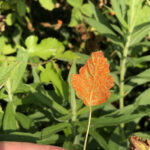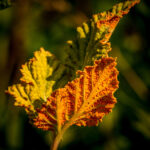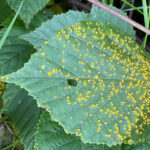When Neil Young was singing about “Rust Never Sleeps,” I doubt he meant orange rust, caused by the fungus Gymnoconia nitens (formerly Arthuriomyces peckianus). But who knows? Maybe he did? And he’d be right: This rust is definitely not sleeping! Despite unusually dry conditions throughout much of the state, orange rust is still making its presence known (Fig.1).
Symptoms of orange rust-infected brambles include spindly shoots with clustered, pale green to yellowish leaves on the upper surface (Fig. 1,2). Turning the leaf over is awe-inspiring: Early in the infection process, leaves look shellacked with orange paint, the diagnostic sign of the disease (Fig. 2). As the lesions mature, smooth waxy blisters develop into bright orange, powdery pustules giving the disease its name “orange rust” (Fig. 3). Lower leaves that are retained may develop dark brown to black pustules (telia) on the lower leaf surface and may get confused with cane and leaf rust (Fig. 4) caused by a different fungus, Kuehneola uredinis, which rarely infects red and black raspberries, and is rarely reported in Indiana.
Symptoms of orange rust infection vary between bramble hosts: Red raspberries are apparently immune to the disease. Black raspberries are highly susceptible, and infected leaves in the lower canopy wither and drop by early summer. At the same time, new leaves produced on the growing tips of the canes appear normal. Blackberries vary in susceptibility, but reliably susceptible blackberry cultivars include Black Diamond, Chester, Chickasaw, Ebony King (conflicting reports), Navaho, Ouachita, and Triple Crown; Primocane-fruiting cultivars Prime-Ark Traveler and Prime-Ark Freedom have also been found to be infected. Note: Not all of these varieties are winter hardy in Indiana.
Although it may appear that the plant has “grown out” of the disease, the disease is systemic: Canes will remain infected, producing infected, blossom-less canes the following spring (Fig. 1). Some primocanes and floricanes may even look healthier later in the season, giving the illusion that the plant ‘got better’. As a systemic infection, those ‘recovered’ but still infected primocanes will produce pustules (aecia)on the underside of leaves, and form spores on newly emerged shoots in the spring, beginning the process anew.
Management:
Despite the dramatic nature of the disease, orange rust can be managed successfully, and reliable crops of black raspberry and blackberry can be obtained!
- Scout for the disease during spring and summer. Inspect planting thoroughly when new canes are between 12 to 18 in.
- Quickly remove and destroy infected plants (to the roots) that show symptoms of spindly growth, or signs of infection. Infected plants culled in early spring limits any spread of orange rust on resprouts in June. Hand‐pull stems and uproot the root ball with first year plants. Manual removal works best after rain or in loose soils. Use of a adze, claw mattock or pulaski is recommended. Recheck area because any large root fragments remaining can re‐sprout and continue the disease cycle.
- Consider the careful application of systemic herbicides to eliminate any rust-infected root suckers. If systemic herbicides must be used, glyphosate in fall is the most effective for selective plant removal. Apply to infected plants only.
- Be sure to plant resistant cultivars, including Arapaho, Apache, Ouachita, Osage, and Natchez, which are erect and thornless. Other options include Cherokee, Cheyenne, Choctaw, Comanche, Shawnee and which are erect and thorny.
- Wild blackberries should be eradicated within the planting, however, the disease can spread within a quarter mile radius, making ‘true’ eradication unlikely.
- Preventive fungicide applications are effective, and recommended fungicides include FRAC 3 fungicides like Rally and Tilt. FRAC 11 containing fungicides include Abound, which performs wells, whereas the pyraclostrobin-containing fungicides Pristine and Merivon are considered suppressive, despite performing as well. The premix Quilt Xcel (FRAC 3+11) is also labeled. Keep in mind that once a plant shows symptoms, it cannot be cured with fungicides and eradication is the only option. Fungicides should be applied every 10-14 days if conditions are dry (including a lack of morning dew) and 7-10 days if conditions are wet, or dew production is heavy.
- Establish new plantings from a clean source or from certified, culture-indexed, tissue-cultured plants.
- Figure 1. Systemic orange rust infection last year led to dramatic symptoms and signs in 2023. No flowers were observed on the infected plant. Photo by Laura Jollie.
- Figure 2. Early infections resemble a coating of orange paint. Photo by Janna Beckerman.
- Figure 3. As lesions(aecia) mature, they turn powdery, releasing aeciospores to infect neighboring plants. Photo by Janna Beckerman.
- Figure 4. Cane and leaf rust presents with yellow, inconspicuous pustules, unlike orange rust. Image from Jan Ole Kriegs from Observations.org.



